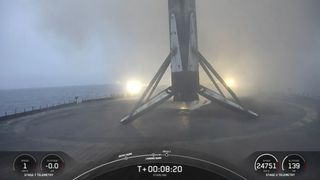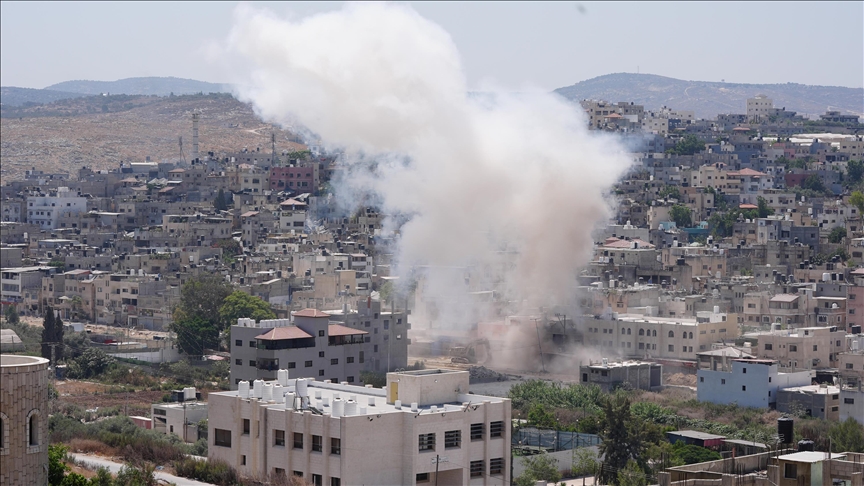GAZA BEACH FRONT DEVELOPER
EXPOSED
Fogbow, a US firm with military links, eyes maritime plan for Gaza aid
A private US firm run by former military and ex-CIA members is pushing plans to build a movable jetty off Gaza’s coast so more lifesaving goods can get into the besieged Palestinian enclave. But UN officials, aid workers and several European government officials have expressed doubts about the project and voiced scepticism over the group’s origins and motives.
Issued on: 12/07/2024 -
France 24
PICTURE POSTCARD
The Gaza coastline near Nuseirat Palestinian refugee camp, with ships in the distance.
LONG READ
By: Jessica LE MASURIERFollow|Dulcie Leimbach
The bid to get humanitarian assistance to Gaza via a sea route has hit troubled waters over the past few months, but it has not stopped a US company run by former military and CIA officials from pushing its controversial plan to secure maritime access to deliver aid to the besieged Palestinian enclave.
At a press conference on Thursday, US President Joe Biden said he was "disappointed" with the problem-plagued effort to deliver aid to Gaza via a temporary pier.
The $230-million US military pier has repeatedly been detached from the shore because of weather conditions since its initial installation in mid-May.
Biden’s comments came hours after the Pentagon announced that the US military was abandoning efforts to reinstall the pier, which was detached last month due to anticipated high seas.
Despite the repeated problems with the pier, Fogbow, a US private firm, is moving forward with its plan, which it calls Blue Beach, to deliver aid to Gaza via a maritime route.
Fogbow’s backstory is replete with deep military, intelligence and financial interests in a region wracked by the nine-month Gaza war whose death toll keeps rising.
Mick Mulroy, a Fogbow company official, recently told FRANCE 24 and PassBlue that the firm is working with USAID, the UN World Food Programme, the US military and a Fogbow-linked charity to pursue the Blue Beach project despite the failure of the US pier.
Fogbow shipped its first pallets of aid, with the help of the US military, on June 27, according to Mulroy. Some 1,100 tons of flour worth “nearly $1 million” – bought by Fogbow from a Cypriot mill – were shipped from the Larnaca port in Cyprus to Gaza.
Fogbow is not only looking to run aid operations into Gaza but also to play a role in its reconstruction, according to numerous UN and US government sources. But inconsistencies in the firm’s messaging and stated goals have left some of these experts questioning the organisation’s agenda.
PassBlue and FRANCE 24 spoke with two of Fogbow’s principals, Mulroy and Chris Hyslop, on a Zoom call in late June and at least 30 people in the US, Cypriot and other European governments, as well as the UN and other NGOs, to shed light on Fogbow’s plans for Gaza.
A mysterious early-morning call
The call set off her alarm bells. It was 8am and Julia*, a human rights specialist, whose reputed NGO has an office near UN headquarters in New York, had just stepped out of the shower when the phone rang. “I’d like to speak to your events manager,” the caller barked.
“Sorry, we don’t have an events organiser. How may I help you?” she asked. The caller said she was from Fogbow, a group Julia had never heard of, which the woman said was exploring alternative ways of getting humanitarian aid into Gaza.
“I explained to the woman on the phone that we are also interested in getting aid into Gaza and suggested we might be able to collaborate,” said Julia.
“There was no, ‘Oh well, let’s all work together’ – which tends to be what the humanitarian community does,” Julia said.
“No,” the Fogbow woman said unequivocally to suggestions of collaborating. “'We are a private company.' What she wanted was to host an event with us in our space in New York.”
After Julia got off the phone, she Googled “Fogbow” and saw that it is mostly made up of former US military and intelligence people. “I thought: ‘Why are they interested in working with us? What are they up to?’”
That’s the same question that a UN front-line aid worker asked himself when a former member of the UN’s Office for the Coordination of Humanitarian Affairs turned up in his office in early February on a charm offensive. Chris Hyslop, a Fogbow official, came armed with a PowerPoint presentation laying out his company’s Blue Beach proposal for a movable pier. He was accompanied by Eric Oehlerich, a former US Navy Seal.
 A slide showing Fogbow's 'Blue Beach Plan' presentation. © France 24
A slide showing Fogbow's 'Blue Beach Plan' presentation. © France 24
The humanitarian aid, Hyslop said, would be bought by Fogbow and shipped through the Amalthea maritime route from the Larnaca port in Cyprus to Gaza that is being promoted by the Cypriot government. The presentation obtained exclusively by FRANCE 24 and PassBlue detailed plans for a “quay” on Gaza’s coastline.

A slide showing Fogbow's 'aid delivery zone'. © France 24
The presentation even addressed plans for “crowd control management” at the “depot area”.
There was good reason to consider crowds: More than 100 people were killed in a stampede in Gaza City in February as people desperately tried to grab some sacks of flour from a food convoy and Israeli forces fired on them.

Fogbow presentation showing Gaza Industrial Estate. © France 24
“They (Hyslop and Oehlerich) claimed they’d met at a kind of county fair, somewhere in the middle of nowhere in America,” the worker said in an interview with PassBlue and FRANCE24.
But for those involved in aid distribution, the plan seemed almost comically out of touch with the realities on the ground in Gaza, where Israel’s relentless bombing in retaliation for the Hamas October 7 massacre has complicated if not halted deliveries as famine looms.
“We sniggered because none of it made any sense,” the UN aid worker continued. “It was so removed from the political reality. It sounded like a crackpot scheme, to be honest.”
“There was something fishy from the start.”
The Fogbow team told the UN worker they had financial backing from “wealthy individuals” and the government of the United Arab Emirates. They said they had also secured the support of the Israel Defence Forces, or IDF, and a tentative green light from COGAT – Israel’s aid coordination cell in the Palestinian territories – to move ahead with the plan.
Who runs Fogbow?
The Fogbow military veterans who run the show include Sam Mundy and Mulroy. The latter is a former naval specialist with the CIA who served in the Trump administration as deputy assistant secretary of defence for the Mideast.
Mulroy was also a director of the Yemen Steering Initiative, “a $50 billion program designed to jumpstart the process to prevent Yemen from becoming a failed state”, according to his LinkedIn page. The initiative was devised, four years ago, by the RAND corporation, a think-tank closely tied to the US defence-intelligence apparatus.
RAND also did a study on the Gaza Arc in 2005, which included plans for a floating maritime dock.
Mundy served as a commander of the Marine Corps Forces Central Command (MARCENT), which is responsible for Marines deployed in the Mideast and participated in a 2022 JINSA Program in Israel focused on underscoring the importance of the US-Israel defence relationship to US national security.
Hyslop brought the UN connections to Fogbow. His LinkedIn bio says he was involved with UN “security” when he worked for the Office for the Coordination of Humanitarian Affairs.
Mulroy told Passblue and FRANCE 24 that Fogbow is owned by three American businessmen: Steven Fox, Robb Fipp and Brook Jerue. Fogbow's website lists the three men as its founders. Fox is also the founder of the corporate intelligence firm Veracity Worldwide, which is based in New York City, and where Jerue is a managing director. Fipp, formerly with Veracity, is in venture capital.

Screen grab from Fogbow's website. © France 24
Fox formerly worked for the State Department, specialising in Israeli and Palestinian affairs, among other regions, according to Fogbow’s website. Yet according to Eamon Javers’s “Broker, Trader, Lawyer, Spy,” a 2011 book about the secret world of corporate espionage, Fox also formerly worked for the CIA.
Mulroy said that Fox, Fipp and Jerue approached him and Hyslop in 2022 to put together an “international humanitarian assistance and disaster relief force to deliver aid to crisis-hit countries, devastated by natural disasters or war”.
That was the initial plan, until “all of a sudden Gaza started”.
“They shifted and said, ‘Can you guys look at what you could do right now in Gaza?’”
Details about Fogbow’s history and operations are scarce on its website, even as it promotes its work without citing examples of “executing complex logistical challenges delivering aid”.

Screen grab from Fogbow's website. © France 24
The site also says that Fogbow “supports the UN’s Connecting Business Initiative”. The UN initiative, however, told FRANCE 24 and PassBlue it had no dealings with Fogbow and had asked repeatedly for the claim to be removed from the organisation's website, without success.
Fogbow describes itself as a provider of humanitarian aid logistics. “We don't pretend to be a humanitarian organisation,” Hyslop said in the Zoom call with him and Mulroy, saying the firm operates merely as a “transporter”.
Hyslop told FRANCE 24 and PassBlue that funding for Fogbow’s movable pier plan would come from the Maritime Humanitarian Aid Foundation (MHAF), a Geneva- and US-based charity run by a former US diplomat, Cameron Hume, who is also an adviser for Veracity.
MHAF has secured funding commitments “in excess” of $50 million “as seed funding from donor governments”, Mulroy said.
“Based on Fogbow’s work under contract with the foundation, there is an expectation of securing significant additional funding from GCC (Gulf Cooperation Council) and other donors.”
Other top advisers at Veracity include Richard Dearlove, who was head of the British intelligence agency known as MI6 (a role known informally as "C”) from 1999 to 2004, including during the US/British invasion of Iraq.
Anatomy of a pier
Mulroy and Hyslop said that they went to the White House twice, in early 2024, to discuss their Blue Beach project. The meetings were set up by Curtis Ried, Chief of Staff of the US National Security Council and Assistant to Brett McGurk, Senior Advisor to the US President for Middle East Affairs. In May, Ried was promoted as the US representative to the OSCE (Organisation for Security and Co-operation in Europe), with the rank of ambassador. They said they also met with Terry Wolff, a retired three-star Army general.
President Joe Biden announced in his State of the Union address on March 7 that he was directing the US military to establish a temporary pier in the Mediterranean near Gaza to bring more food and other essentials into the Palestinian enclave.
The timing was urgent: Three senior UN officials warned the UN Security Council on February 27 of “imminent famine in the Gaza Strip”, pushing for “immediate action to avert humanitarian disaster in a territory where many Council members alleged the use of hunger as a weapon of war”.
But aid groups and others have insisted that the overland routes into Gaza blockaded by Israel’s military operation remain the best way to get aid into the enclave.
US Army Major Harrison Mann described the US jetty as a PR stunt, saying: “The pier and the airdrops look like they were intended to satisfy Americans who were concerned about the suffering of Palestinians, but I’m not sure what segment of the population both deeply cares about the welfare of Palestinians but is not engaged enough to see the failure of both the pier and the airdrop projects,” he told FRANCE 24 and PassBlue.
Major Mann was the first US military and intelligence officer to resign publicly over the Biden administration’s support of Israel’s war on Gaza.
Meanwhile, Fogbow was negotiating a role in the maritime route from Cyprus to Gaza. Fogbow tried to clinch contracts with USAID and the State Department, but they were unsuccessful – partly because the firm had no history of delivering aid in the region, according to government sources who did not want to speak on the record.
Stacy Gilbert, who spent over two decades working for the State Department’s Bureau of Population, Refugees and Migration, said that maritime aid plans would do little to alleviate the suffering in Gaza.
“For people who know anything about humanitarian assistance, the US pier doesn't make any sense because the whole reason we are doing it is because our ally Israel is blocking humanitarian assistance,” she said, adding that the money used to build the pier could have been better spent.
Gilbert resigned from the Biden administration after a controversial report to which she contributed (the NSM-20 report released May 10) concluded that Israel was not obstructing humanitarian aid to Gaza despite credible evidence to the contrary.
A USAID branch called the Bureau of Humanitarian Assistance spearheads global aid in crisis situations, with a US government source saying, “When there’s an international disaster [it] is the lead – period.”
The source said that Fogbow’s lack of respect for the lead agency (USAID) and their lack of a track record reek of “profiteering”.
“When DoD is invited to support a response, then they can use the resources they have (such as ships) to speed things up. When it comes to working with a private firm like Fogbow it has to be contracted out by the DoD," the US government source told FRANCE 24 and PassBlue. "Typically, DoD lawyers would say no, unless it was for something specific to their needs like vessel recovery.”
Fogbow said it did make some of its leased tugboats available to support the US pier operation.
Avoiding pitfalls
In an email to PassBlue, Ann Wright, a member of the Freedom Flotilla Coalition, a nongovernmental organisation that has been trying to sail aid into Gaza, was dubious about the role Fogbow is striving to play in the region. Wright served in the US Army and Reserves for 29 years as well as 16 years as a diplomat. She resigned in 2003 in opposition to the US war in Iraq.
“The fact that most of the Fogbow staff are retired US military and CIA officials definitely has a ‘smell to it’ of a US covert operation,” Wright wrote in her email.
Gilbert noted: “Humanitarian organizations use former military [experts] in various roles. I think what gives us pause is when the Department of Defence is contracting for work in humanitarian assistance that they (the military) should not be doing.”
In the interview with FRANCE 24 and PassBlue in late June, Hyslop took umbrage with assumptions about Fogbow’s motives simply because of its principals’ extensive CIA and military backgrounds.
“I've never heard any humanitarian ask Maersk or APL (logistics) or major global shippers if they have former military people on their staff,” Hyslop said on the Zoom call. “Of course they do. All their logisticians primarily come from world militaries and no questions are asked. But they're asked of us. And I understand it.”
“But I also ask for some understanding from the perspective of the humanitarians, and to give our boys a chance to explain that these are not active military people,” he added. “They've properly and respectfully served their countries and now they're bringing these skills now in support of the humanitarian community, not to take over in any way.”
Mulroy told PassBlue and FRANCE 24 that the firm plans to build the movable pier as outlined in the Blue Beach proposal: a $20 million structure with a crane that will be better adapted to rough seas than the US pier has been.
Fogbow’s offshore project would involve their ocean-going barges being pushed by tugs from the Larnaca port, carrying up to 150 truck-equivalent units.
The landing zone would bring an “additive route” to overland roads and be “impervious to weather conditions and wave heights”, Mulroy said, describing how the project would work. “It's essentially on the beach and it has sea breaks and all that stuff.”
There would be a “short quay wall” and a “dredged slot” that the barges can be pulled onto the beach. Then “the containers are just offloaded with no dock or causeway”, Mulroy said.
Fogbow emphasised that their design would avoid the technical problems encountered by the US military pier.
A Palestinian billionaire, Bashar al Masri, is in discussions about partnering with Fogbow for storage and distribution of aid, according to UN sources. Al Masri previously financed the reconstruction of the Gaza Industrial Estate after it was destroyed in Israel’s 11-day offensive on Gaza in 2021. Masri built the enclave’s first luxury hotel, called Blue Beach, which was near the spot where the US pier was constructed.
But a Gazan photographer, Mohammed Hajjar, who is based in the enclave, said that Al Masri is regarded with suspicion by the local population, “Most Gazans don’t know him. We don’t know his politics, his goals, what his political programme is. My opinion [is] he is not in a position to be part of any solutions in post-war Gaza.”
“He came to Gaza once and seemed interested in trade. All of his solutions were for-profit options.”
Salman Al-Zurai’i, a Palestinian researcher and policy analyst based in Gaza, said to FRANCE 24 and PassBlue about Al Masri: “I think that Al Masri – and generally the private sector – are going to play a large role in the day after the war in Gaza.”
“The involvement of the Palestinian private sector, local stakeholders and Gazan clans in running post-war Gaza implies that neither the Palestinian Authority nor Hamas will play a role, resulting in a political vacuum in Gaza,” he added.
“The Israelis want to prevent Palestinian political actors from participating in post-war Gaza; this is a major Israeli approach that has been ongoing for 17 years and led to cementing the political separation of the Gaza Strip and the West Bank.”
The idea for a sea entry point into Gaza was floated by Israeli Prime Minister Binyamin Netanyahu in October 2023, according to The Jerusalem Post. It was not the first time Israel had proposed a floating island off the coast of Gaza purportedly to facilitate aid delivery.
Israeli media reported in March on Netanyahu’s post-war vision for the Gaza strip, known as “Gaza 2035”. The document, later published online by Netanyahu’s office (on May 3), promotes the idea that Gaza “can become a significant industrial production centre for the shores of the Mediterranean with … access to… energy and raw materials from the Gulf while leveraging Israeli technology”.

Image from Israeli PM Netanyahu's Gaza 2035 plan. © France 24
The plan would keep Gaza under Israeli control – and allow it to exploit the enclave’s offshore energy reserves, estimated at 1.1 trillion cubic feet of natural gas – while an Arab Coalition (including the UAE and Saudi Arabia) would create a body called the Gaza Rehabilitation Authority to oversee the reconstruction efforts. The plan does not appear to give Palestinians any operative role.
UAE Foreign Minister Sheikh Abdullah bin Zayed Al Nahyan denounced Netanyahu’s plans on X shortly after their release, making it clear that the Israeli PM had not consulted Abu Dhabi.
“The UAE stresses that the Israeli Prime Minister does not have the legal capacity to take this step, and the state refuses to be drawn into any plan aimed at providing cover for Israeli presence in the Gaza Strip,” the post read.
Fogbow eyes postwar reconstruction
Humanitarians expressed concern about the prospect of Fogbow playing a role in Gaza’s rebuilding once the war ends.
Jamie McGoldrick met with Fogbow three times earlier this year when he was the UN’s humanitarian aid coordinator for the Occupied Palestinian Territory, along with David Satterfield, then the US special envoy for the Middle East. McGoldrick said the firm was “not very transparent” about their intentions, including sources of funding – as Fogbow’s name, which means ghost rainbow, might suggest.
During a first meeting in February with McGoldrick and Satterfield, Fogbow’s representatives pitched a project not directly related to humanitarian assistance: a maritime corridor to be used for the reconstruction of Gaza. They said that the corridor could help with aid delivery if needed, but that was not its original purpose.
“What they told us about was this idea of having a supply route for reconstruction into Gaza because they saw an opportunity there – initially they were in conversations with Qatar then shifted to UAE for support,” McGoldrick said.
“They needed something like $300 million to set the whole thing up,” he added. “And they were looking for suitors, that was one of the reasons why I think they were in the room with Satterfield and others – to try and convince them to contribute to this or to be part of it.”
McGoldrick said that Fogbow’s operations in the region may be a way for the US to get into the Gaza reconstruction market.
A representative from the team of Sigrid Kaag, the US-backed senior UN humanitarian aid and reconstruction coordinator for Gaza, was also in one of the meetings with Fogbow. Her team has not responded to our questions sent by email.
McGoldrick said that conversations about the future of Gaza are now under way: Will it go from “Mogadishu on the Med to Singapore on the Med or another Dubai?", he asked. UN officials calculate that Gaza’s postwar reconstruction could cost $30 to $40 billion, but no one is saying where the money will come from.
“I worked in many places” – including in Yemen – “where I came across these private firms,” McGoldrick added, referring to Fogbow.
“And, you know, they're not there for the human dimension of things, they’re there for profit,” he said. “American Navy SEALS, nice, shiny, connected politically and they have financial muscle behind them. You've always got to be suspicious of it.”
A model for post-war Gaza similar to the post-US invasion reconstruction operation in Iraq has been floated, McGoldrick noted. The US government official Paul Bremer ran the Coalition Provisional Authority after the 2003 US invasion and was unofficially governor of Baghdad. Both former British Prime Minister and Mideast Quartet negotiator Tony Blair – who has an office in Tel Aviv – and Kaag, who is also a former Dutch politician, have been name-dropped as possible main players in the post-reconstruction effort.
By using the Cyprus maritime corridor from Larnaca to the Gaza coast, prospectors could sideline “the Egyptians in Port Said.” Such a project, McGoldrick added, would create a channel “that’s controlled more by the Emirates and other Gulf countries who want to get a piece of Gaza”.
“The project could cut Palestinians out of the picture,” noted McGoldrick, as it “likely increases the separation of Gaza from the West Bank”.
“I think it's dangerous … because you want to create a settled environment there if you're going to have a prospect for peace for Gaza,” he said. “It's got to be Gaza for Gazans.”
*Name has been changed
















 A slide showing Fogbow's 'Blue Beach Plan' presentation. © France 24
A slide showing Fogbow's 'Blue Beach Plan' presentation. © France 24



